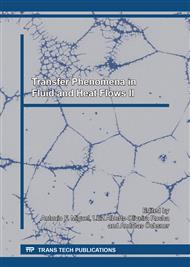[1]
V. V. Vasiliev and E. V. Morozov. Advanced mechanics of composite materials. 2nd edn. Amsterdam and London: Elsevier, (2007).
Google Scholar
[2]
J. R. Vinson and R. L. Sierakowski. The behavior of structures composed of composite materials. 2nd ed. Vol. 105. Solid mechanics and its applications. Dordrecht and London: Kluwer Academic Publishers, (2002).
DOI: 10.1007/0-306-48414-5
Google Scholar
[3]
R. M. Jones. Mechanics of composite materials. 2nd ed. Philadelphia, Pa. and London: Taylor & Francis, (1999).
Google Scholar
[4]
J. N. Coleman et al. Small but strong: A review of the mechanical properties of carbon nanotube- polymer composites. Carbon 44 (2006), pp.1624-1652.
DOI: 10.1016/j.carbon.2006.02.038
Google Scholar
[5]
S. Iijima. Helical microtubules of graphitic carbon. Nature 354 (1991), pp.56-58.
DOI: 10.1038/354056a0
Google Scholar
[6]
E. T. Thostenson, Z. Ren, and T. -W. Chou. Advances in the science and technology of carbon nanotubes and their composites: A review. Compos. Sci. Technol. 61 (2001), p.1899-(1912).
DOI: 10.1016/s0266-3538(01)00094-x
Google Scholar
[7]
E. T. Thostenson, C. Li, and T. -W. Chou. Nanocomposites in context. Compos. Sci. Technol. 65 (2005), pp.491-516.
Google Scholar
[8]
S. Berber, Y. -K. Kwon, and D. Tománek. Unusually High Thermal Conductivity of Carbon Nanotubes. Phys. Rev. Lett. 84 (2000). May, pp.4613-4616.
DOI: 10.1103/physrevlett.84.4613
Google Scholar
[9]
Z. Han and A. Fina. Thermal conductivity of carbon nanotubes and their polymer nanocomposites: A review. Prog. Polym. Sci. 36 (2011), pp.914-944.
DOI: 10.1016/j.progpolymsci.2010.11.004
Google Scholar
[10]
N. Behabtu et al. Strong, light, multifunctional fibers of carbon nanotubes with ultrahigh conductivity. Science 339 (2013), pp.182-186.
Google Scholar
[11]
R. H. Baughman, A. A. Zakhidov, and W. A. de Heer. Carbon nanotubes-the route toward applications. Science 297 (2002), pp.787-792.
DOI: 10.1126/science.1060928
Google Scholar
[12]
R. S. Ruoff and D. C. Lorents. Mechanical and thermal properties of carbon nanotubes. Carbon 33 (1995), pp.925-930.
DOI: 10.1016/0008-6223(95)00021-5
Google Scholar
[13]
H. Chen et al. Thermal conductivity of polymer-based composites: Fundamentals and applications. Prog. Polym. Sci. 59 (2016), pp.41-85.
Google Scholar
[14]
M. Mahdavi et al. Effective thermal and mechanical properties of short carbon fiber/natural rubber composites as a function of mechanical loading. Appl. Therm. Eng. 117 (2017), pp.8-16.
DOI: 10.1016/j.applthermaleng.2017.02.004
Google Scholar
[15]
H. R. Lusti and A. A. Gusev. Finite element predictions for the thermoelastic properties of nanotube reinforced polymers. Modelling Simul. Mater. Sci. Eng. 12 (2004), S107-S119.
DOI: 10.1088/0965-0393/12/3/s05
Google Scholar
[16]
I. E. Afrooz and A. Öchsner. Effect of the Carbon Nanotube Distribution on the Thermal Conductivity of Composite Materials. J. Heat Transfer 137 (2015), p.034501.
DOI: 10.1115/1.4029034
Google Scholar
[17]
N. Khani, M. Yildiz, and B. Koc. Elastic properties of coiled carbon nanotube reinforced nanocomposite: A finite element study. Mater. Des. 109 (2016), pp.123-132.
DOI: 10.1016/j.matdes.2016.06.126
Google Scholar
[18]
R. Makvandi and A. Öchsner. On a Finite Element Approach to Predict the Thermal Conductivity of Carbon Fiber Reinforced Composite Materials. Defect. Diffus. Forum 354 (2014), pp.215-225.
DOI: 10.4028/www.scientific.net/ddf.354.215
Google Scholar
[19]
S. R. Bakshi, R. R. Patel, and A. Agarwal. Thermal conductivity of carbon nanotube reinforced aluminum composites: A multi-scale study using object oriented finite element method. Comput. Mater. Sci. 50 (2010), pp.419-428.
DOI: 10.1016/j.commatsci.2010.08.034
Google Scholar
[20]
H. S. Hedia et al. Effect of agglomeration and dispersion on the elastic properties of polymer nanocomposites: A Monte Carlo finite element analysis. MP 58 (2016), pp.269-279.
DOI: 10.3139/120.110843
Google Scholar
[21]
K. Alasvand Zarasvand and H. Golestanian. Determination of nonlinear behavior of multiwalled carbon nanotube reinforced polymer: Experimental, numerical, and micromechanical. Mater. Des. 109 (2016), pp.314-323.
DOI: 10.1016/j.matdes.2016.07.071
Google Scholar
[22]
X. L. Chen and Y. J. Liu. Square representative volume elements for evaluating the effective material properties of carbon nanotube-based composites. Comput. Mater. Sci. 29 (2004), pp.1-11.
DOI: 10.1016/s0927-0256(03)00090-9
Google Scholar
[23]
I. V. Belova et al. The Lattice Monte Carlo Method for Solving Phenomenological Mass and Thermal Diffusion Problems. Defect. Diffus. Forum 279 (2008), pp.13-22.
DOI: 10.4028/www.scientific.net/ddf.279.13
Google Scholar
[24]
I. V. Belova et al. The lattice Monte Carlo method for solving phenomenological mass and heat transport problems. DDC 4 (2007), pp.15-1.
Google Scholar
[25]
A. Öchsner and M. Merkel. One-Dimensional Finite Elements: An Introduction to the FE Method. Berlin and Heidelberg: Springer, (2013).
Google Scholar
[26]
A. Öchsner. Computational statics and dynamics: An introduction based on the finite element method. Singapore: Springer, (2016).
Google Scholar
[27]
Z. Javanbakht and A. Öchsner. Advanced finite element simulation with MSC Marc: Application of user subroutines. Cham: Springer, (2017).
DOI: 10.1007/978-3-319-47668-1
Google Scholar
[28]
T. Fiedler, E. Solórzano, and A. Öchsner. Numerical and experimental analysis of the thermal conductivity of metallic hollow sphere structures. Mater. Lett. 62 (2008), pp.1204-1207.
DOI: 10.1016/j.matlet.2007.08.050
Google Scholar
[29]
T. Fiedler et al. A refined finite element analysis on the thermal conductivity of perforated hollow sphere structures. Comput. Mater. Sci. 47 (2009), pp.314-319.
DOI: 10.1016/j.commatsci.2009.08.007
Google Scholar
[30]
Z. Javanbakht, W. Hall, and A. Öchsner. Automatized Estimation of the Effective Thermal Conductivity of Carbon Fiber Reinforced Composite Materials. Defect. Diffus. Forum 370 (2016), pp.177-183.
DOI: 10.4028/www.scientific.net/ddf.370.177
Google Scholar
[31]
MSC Software Corporation. Marc 2015: Theory and User Information. Vol. A. Newport Beach, California: MSC Software Corporation, (2015).
Google Scholar


